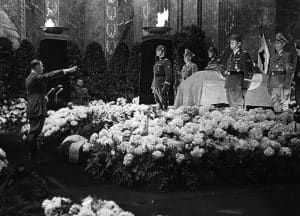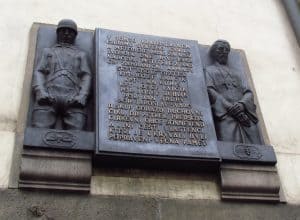A month ago, the peaceful and visitor-friendly city of Prague heard the terrifying sound of gunfire. The incident left fourteen people dead and nearly twice that number wounded. In a place that has enjoyed a great deal of peace – Prague even escaped the worst of the damage of the Second World War – news of the incident brought back wartime memories, when gunfire broke its quietude. A memorial to that decades-past incident lies in a cathedral in a quiet corner of the city. A cathedral with bullet marks on its walls. A cathedral where a paratrooper and a priest stand side by side. Carved in stone. To understand the relationship between these contrasting figures, one needs to go back in time to Prague’s past, to a time when it came under the jackbooted rule of German occupation. Prague under the Germans It was in October 1938, prior to the Second World War, that a part of Czechoslovakia, called Sudetenland, was occupied by Germany. In March the following year, Hitler declared the entire country to be the Protectorate of Bohemia and Moravia with the real power of this state residing in the hands of a Reich Protector. From being a democracy, the country effectively was now a German-run police state. The immense industrial capacity of this region made it the arsenal of a Germany that would plunge the world into conflict months later. The loss of their freedom, the threat of being forcibly merged into a greater Germanic identity and being forced to be part of a regime they hated led to the creation of a resistance movement among Czech patriots. [caption id=“attachment_13662872” align=“alignnone” width=“300”] Adolf Hitler at Prague Castle, 1939 - Source Wikipedia[/caption] The terror of ‘Hangman’ Heydrich Matters turned worse with the appointment of Reinhard Heydrich as Deputy Reich Protector of this protectorate. Heydrich, one of the darkest figures of the Nazi regime, was the founder of the dreaded SD – responsible for arrests, deportations and murders through the regime. A task force created by him was responsible for the murder of more than two million people in German-occupied Europe. Within five days of his arrival in Prague, 142 people were executed and several thousand sent to concentration camps. In his own words, his mission here was to “Making this Czech garbage into Germans must give way to methods based on racist thought." Operation Anthropoid and its aftermath The Czechoslovak government-in-exile decided to eliminate Heydrich, for which Czech patriots trained by the British Special Operation Executive (SOE) were parachuted into the area. Among them were Jan Kubiš and Jozef Gabčík. On May 27, 1942, they attacked Heydrich’s car. When Gabčík’s submachine gun jammed, Kubiš threw an anti-tank mine into the car with the resulting explosion severely wounding Heydrich. After enduring a slice of the agony he had inflicted on millions of others, Heydrich died on June 4. [caption id=“attachment_13662882” align=“alignnone” width=“300”]
 Adolf Hitler salutes at Heydrich’s funeral in Germany - Source Wikipedia[/caption] The Nazi regime unleashed a wave of reprisals, including the depopulation of two Czech villages, in which adult male inhabitants were shot while all the others were taken to a concentration camp. Amidst this, Heydrich was given a grand funeral in Germany while a manhunt was launched to nab Kubiš, Gabčík and any others who provided support to them. The hunt climaxed in the unlikeliest of places, a place of worship. Recollecting church history Built in the 1730s, the St. Cyril and Methodius Cathedral is a fine baroque structure. Originally, it was called the St. Charles Borromeo Roman Catholic Church, named after a 16th century archbishop of Milan. It was part of a home for retired priests and an underground level contained a crypt for the tombs of these priests. An order of the Austrian emperor changed it from a church into an army storehouse in 1783. In 1869, the place became a Czech technology centre and eventually, in 1921, the Czech Orthodox Church made it their cathedral. In the middle of 1942, the patriots who had assassinated Heydrich took shelter in the building, having found it impossible to penetrate the German dragnet spread through Prague. Last battle The seven men who took shelter in the cathedral were betrayed and on June 18, 1942, the place was surrounded by hundreds of German soldiers. A savage gun battle followed. The defenders fell back into the underground crypt and unable to break through, the Germans used fire hoses to flood the place. With odds of 100:1, lack of ammunition and no escape, the one-sided battle could only have one end. Three of the defenders were killed in the battle while four others took their own lives rather than fall into the hands of the enemy. The Germans didn’t stop with just the armed defenders. Over the next two months, members of the Orthodox Church who had helped the Czech patriots take refuge within were executed. A memorial Today, as a visitor enters the cathedral, the magnificence of the structure is striking, even in a city which has other superb churches. The upper level is richly embellished, with paintings and divine figures. But when one goes to the crypt below, the mood is sombre. Busts of the martyrs, their uniforms, written accounts of their individual stories and personal items like uniforms and weapons make it a strange place to see, just below a place of worship. Drawings of visiting children show the respect with which the sacrifice of the martyrs is held. [caption id=“attachment_13662902” align=“alignnone” width=“409”]
Adolf Hitler salutes at Heydrich’s funeral in Germany - Source Wikipedia[/caption] The Nazi regime unleashed a wave of reprisals, including the depopulation of two Czech villages, in which adult male inhabitants were shot while all the others were taken to a concentration camp. Amidst this, Heydrich was given a grand funeral in Germany while a manhunt was launched to nab Kubiš, Gabčík and any others who provided support to them. The hunt climaxed in the unlikeliest of places, a place of worship. Recollecting church history Built in the 1730s, the St. Cyril and Methodius Cathedral is a fine baroque structure. Originally, it was called the St. Charles Borromeo Roman Catholic Church, named after a 16th century archbishop of Milan. It was part of a home for retired priests and an underground level contained a crypt for the tombs of these priests. An order of the Austrian emperor changed it from a church into an army storehouse in 1783. In 1869, the place became a Czech technology centre and eventually, in 1921, the Czech Orthodox Church made it their cathedral. In the middle of 1942, the patriots who had assassinated Heydrich took shelter in the building, having found it impossible to penetrate the German dragnet spread through Prague. Last battle The seven men who took shelter in the cathedral were betrayed and on June 18, 1942, the place was surrounded by hundreds of German soldiers. A savage gun battle followed. The defenders fell back into the underground crypt and unable to break through, the Germans used fire hoses to flood the place. With odds of 100:1, lack of ammunition and no escape, the one-sided battle could only have one end. Three of the defenders were killed in the battle while four others took their own lives rather than fall into the hands of the enemy. The Germans didn’t stop with just the armed defenders. Over the next two months, members of the Orthodox Church who had helped the Czech patriots take refuge within were executed. A memorial Today, as a visitor enters the cathedral, the magnificence of the structure is striking, even in a city which has other superb churches. The upper level is richly embellished, with paintings and divine figures. But when one goes to the crypt below, the mood is sombre. Busts of the martyrs, their uniforms, written accounts of their individual stories and personal items like uniforms and weapons make it a strange place to see, just below a place of worship. Drawings of visiting children show the respect with which the sacrifice of the martyrs is held. [caption id=“attachment_13662902” align=“alignnone” width=“409”] A paratrooper and a priest stand together in a memorial plaque outside the church[/caption] On the outer wall of the cathedral, above one of the openings through which the Germans filled water within the crypt, are bullet marks – preserved to keep the memory alive. Above the opening is a plaque listing the names of the men who died, both the defenders as well as members of the clergy. Flanking that list are a paratrooper and a priest. Standing by each other the way they did in life over eight decades ago. And unlike the shooter of December 2023, the patriots of 1942 fought for a cause. The author is a heritage explorer by inclination with a penchant for seeking obscure sites. A brand consultant by profession, he tweets @HiddenHeritage. Views expressed in the above piece are personal and solely that of the author. They do not necessarily reflect Firstpost_’s views._ Read all the
Latest News ,
Trending News ,
Cricket News ,
Bollywood News , India News and
Entertainment News here. Follow us on
Facebook,
Twitter and
Instagram.
A paratrooper and a priest stand together in a memorial plaque outside the church[/caption] On the outer wall of the cathedral, above one of the openings through which the Germans filled water within the crypt, are bullet marks – preserved to keep the memory alive. Above the opening is a plaque listing the names of the men who died, both the defenders as well as members of the clergy. Flanking that list are a paratrooper and a priest. Standing by each other the way they did in life over eight decades ago. And unlike the shooter of December 2023, the patriots of 1942 fought for a cause. The author is a heritage explorer by inclination with a penchant for seeking obscure sites. A brand consultant by profession, he tweets @HiddenHeritage. Views expressed in the above piece are personal and solely that of the author. They do not necessarily reflect Firstpost_’s views._ Read all the
Latest News ,
Trending News ,
Cricket News ,
Bollywood News , India News and
Entertainment News here. Follow us on
Facebook,
Twitter and
Instagram.
Built in the 1730s, the St. Cyril and Methodius Cathedral is a fine baroque structure
Advertisement
End of Article


)

)
)
)
)
)
)
)
)



